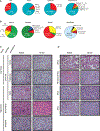A renal cell carcinoma tumorgraft platform to advance precision medicine
- PMID: 34818533
- PMCID: PMC8762721
- DOI: 10.1016/j.celrep.2021.110055
A renal cell carcinoma tumorgraft platform to advance precision medicine
Abstract
Renal cell carcinoma (RCC) encompasses a heterogenous group of tumors, but representative preclinical models are lacking. We previously showed that patient-derived tumorgraft (TG) models recapitulate the biology and treatment responsiveness. Through systematic orthotopic implantation of tumor samples from 926 ethnically diverse individuals into non-obese diabetic (NOD)/severe combined immunodeficiency (SCID) mice, we generate a resource comprising 172 independently derived, stably engrafted TG lines from 148 individuals. TG lines are characterized histologically and genomically (whole-exome [n = 97] and RNA [n = 102] sequencing). The platform features a variety of histological and oncogenotypes, including TCGA clades further corroborated through orthogonal metabolomic analyses. We illustrate how it enables a deeper understanding of RCC biology; enables the development of tissue- and imaging-based molecular probes; and supports advances in drug development.
Keywords: BAP1; HIF; NGS; PET; PT2385; TAK-243; VHL; animal models; belzutifan; biomarkers; iPET; immunoPET; kidney cancer; metabolomics; molecular imaging; radiotracer; patient-derived xenograft (PDX); renal cell carcinoma (RCC).
Copyright © 2021 The Authors. Published by Elsevier Inc. All rights reserved.
Conflict of interest statement
Declaration of interests J.B. is an employee/paid consultant for Arrowhead, Calithera, Esai, Exelixis, and Johnson & Johnson and reports receiving commercial research grants from Arrowhead. J.B. and X.S. have a patent application on [(18)F]PT2385. I.P. reports personal fees from Bayer Healthcare and Health Tech International, personal fees for serving in an Advisory Committee for Merck, and others from Philips Healthcare, all outside of the submitted work. R.J.D. is a founder of Atavistik Bio and a member of the Scientific Advisory Boards of Agios Pharmaceuticals, Vida Ventures, and Nirogy Therapeutics.
Figures







References
Publication types
MeSH terms
Grants and funding
LinkOut - more resources
Full Text Sources
Miscellaneous

